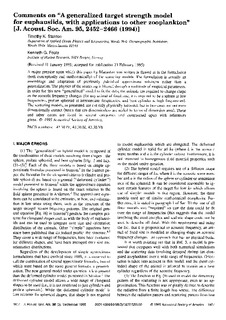| dc.contributor.author | Stanton, Timothy K. | |
| dc.contributor.author | Foote, Kenneth G. | |
| dc.date.accessioned | 2007-07-03T12:28:56Z | |
| dc.date.issued | 1995 | |
| dc.identifier.uri | http://hdl.handle.net/11250/108033 | |
| dc.description | Main article at http://dx.doi.org/10.1121/1.409855. Journal home page: http://scitation.aip.org/jasa/ | |
| dc.description.abstract | A major premise upon which this paper by Macaulay was written is flawed as is the formulation (both conceptually and mathematically) of the scattering models. The formulation is actually an assemblage and adaptation of previously published approximate solutions rather than a generalization. The physics of the scattering is blurred through a multitude of empirical parameters. In order for this new ``generalized'' model to fit the data, the animals are required to change shape as the acoustic frequency changes (for any animal of fixed size, it is required to be a sphere at low frequencies, prolate spheroid at intermediate frequencies, and bent cylinder at high frequencies). The scattering models, as presented, are not only physically incorrect, but in two cases are not even dimensionally correct (terms that are dimensionless are added to terms of dimension area). These and other errors are listed in several categories and commented upon with references given. | en |
| dc.format.extent | 316032 bytes | |
| dc.format.mimetype | application/pdf | |
| dc.language.iso | eng | en |
| dc.subject | scattering models | en |
| dc.title | Comments on "A generalized target strength model for euphausiids, with applications to other zooplankton" [J. Acoust. Soc. Am. 95, 2452–2466 (1994)] | en |
| dc.type | Journal article | en |
| dc.type | Peer reviewed | |
| dc.source.pagenumber | 1807-1809 | en |
| dc.source.volume | 98 | en |
| dc.source.journal | The Journal of the Acoustical Society of America | en |
| dc.source.issue | 3 | en |
| dc.identifier.doi | http://dx.doi.org/10.1121/1.413380 | |
